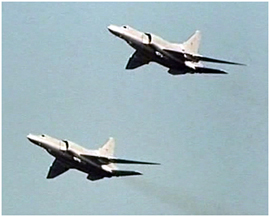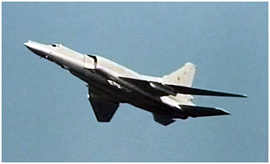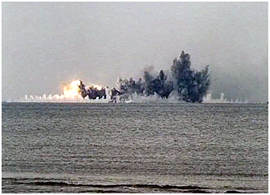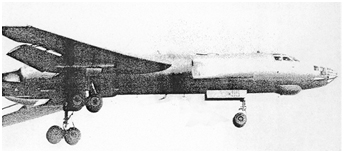 Un Tu-16P Bouket "Badger-J" saisi au décollage à Oranienburg en mai 1980. © USMLM.
Un Tu-16P Bouket "Badger-J" saisi au décollage à Oranienburg en mai 1980. © USMLM.
A Tu-16P Buket "Badger-J" taking off from Oranienburg in May 1980. © USMLM.
Soviet tactical air units stationed in the Warsaw Pact countries and other units from "brother countries" (mainly Poland and Czechoslovakia) were regularly
deployed on airfields in East Germany, or visited the local firing ranges. For the Soviets, these visits consisted mainly in air-to-air firing campaigns over
the Baltic Sea or air-to-ground firing on the ground firing ranges, while visitors from other countries of the Warsaw Pact came essentially during large joint
exercises like "Waffenbrüderschaft" (weapons brotherhood). In addition, the Czechs also used the air-to-air firing range situated off the Rügen island
(see > The target-towing units).
But other more unexpected visitors coming directly from the USSR flew on a regular basis to East Germany: the heavy bombers of the Dal'nyaya Aviatsiya (Long-range
aviation, which can be undesrstood here as strategic aviation) and those of the Soviet Navy Air Component (Aviatsiya Voyenno-Morskogo Flota - AVMF).
These visits could take different aspects: navigation exercises, temporary deployments or even raids on a
firing range sometimes without landing in the GDR. With the exception of some testimonies of Soviet origin, the information available on these activities are rare and
are mainly coming from Western intelligence services.
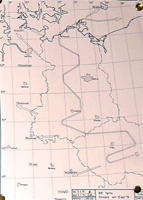
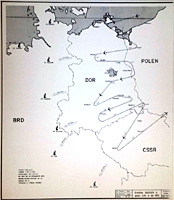 The visiting aircraft during the years 1960-1980 were Tupolev Tu-16 "Badger" of various versions, Tu-22 "Blinder"
versions, Tu-22M2 "Backfire-B" and Tu-22M3 "Backfire-C." During the Cold War, the Tu-22M2/M3 were incorrectly designated Tu-26 in the West.
Bombers, often from the 46.VA at Smolensk (1), joined the GDR fairly regularly through long-range navigation exercises.
They approached the East German airspace from the north, along the coast of the Baltic Sea in two-ship formations, passing successively under the air trafic
control of Gdansk, Kolobrzeg and Damgarten. The flight altitude was at 9450 or 10500 meters.
The visiting aircraft during the years 1960-1980 were Tupolev Tu-16 "Badger" of various versions, Tu-22 "Blinder"
versions, Tu-22M2 "Backfire-B" and Tu-22M3 "Backfire-C." During the Cold War, the Tu-22M2/M3 were incorrectly designated Tu-26 in the West.
Bombers, often from the 46.VA at Smolensk (1), joined the GDR fairly regularly through long-range navigation exercises.
They approached the East German airspace from the north, along the coast of the Baltic Sea in two-ship formations, passing successively under the air trafic
control of Gdansk, Kolobrzeg and Damgarten. The flight altitude was at 9450 or 10500 meters.
Three scenarios were then possible:
- Turn around and heading east
- Down to the south under the orders of Wittstock, turn east under the successive control
of Werneuchen,
Poznan, Warsaw... (or conversely from south to north)
- Down to the south under the orders of Wittstock, Zerbst, Altenburg, Milovice (CSSR) and turn east (or conversely from south to north).
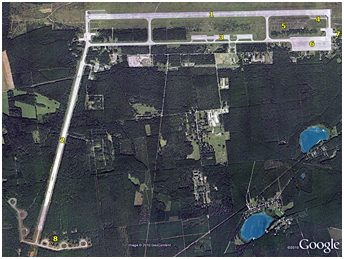 While following these last two itineraries, the bombers sometimes followed a sawtooth path, apparently totally incomprehensible.
Yet, when one drew a line at the turning point, it lead inevitably to NATO radar stations (2)
located on the West German territory. While one aircraft was likely to launch an anti-radar missile, the second protected the raid with electronic counter-measures.
The aim was to blind the NATO defenses and thus create penetration corridors (3).
But perhaps was it simply a provocative action to force the radars to switch from standy to active mode in order to collect their characteristics
(see > "Blinder over Berlin"). Industrial centers were also targeted during those particular itineraries.
Overflights - with descent to 300 m - could intervene
over the Wittstock firing range, but the bombers did not necessarily dropped bombs. Guards Colonel Valeri Tamarovski, commander of the 20.GvAPIB at Gross Dölln between 1989
and early 1993, stated in a letter that Tu-22[M] regularly visited Gross Dölln during navigation exercises. The aircraft remained four to six hours on site
or spent the night there - is it an allusion to the story related in "Blinder over Berlin"? - before leaving.
While following these last two itineraries, the bombers sometimes followed a sawtooth path, apparently totally incomprehensible.
Yet, when one drew a line at the turning point, it lead inevitably to NATO radar stations (2)
located on the West German territory. While one aircraft was likely to launch an anti-radar missile, the second protected the raid with electronic counter-measures.
The aim was to blind the NATO defenses and thus create penetration corridors (3).
But perhaps was it simply a provocative action to force the radars to switch from standy to active mode in order to collect their characteristics
(see > "Blinder over Berlin"). Industrial centers were also targeted during those particular itineraries.
Overflights - with descent to 300 m - could intervene
over the Wittstock firing range, but the bombers did not necessarily dropped bombs. Guards Colonel Valeri Tamarovski, commander of the 20.GvAPIB at Gross Dölln between 1989
and early 1993, stated in a letter that Tu-22[M] regularly visited Gross Dölln during navigation exercises. The aircraft remained four to six hours on site
or spent the night there - is it an allusion to the story related in "Blinder over Berlin"? - before leaving.
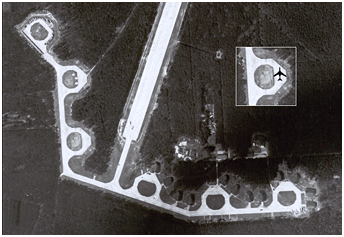 Some missions were intended to check the readiness state of the Warsaw Pact forces. A former crew member from the 57th Naval Missile Aviation Division
(Morskaya Raketnaya Aviatsionnaya Divisiya - MRAD) based at Bykhov in Belarus described one of his missions as follows: "There were lot of flights
carried out to test air defense readiness. We flew Tu-16s (and later Tu-22s) and we also checked the alert status of the Warsaw Pact Air Defence Forces.
One Sunday evening, we took off and headed south in a cloudless sky. Radio silence and IFF turned off. As a precaution, the radio was turned to channel 1 [124.000 MHz -
Warsaw Pact ATC common channel] and channel 3 [130.750 MHz - Warsaw Pact common channel for training] in order to be able to communicate with fighters
if necessary. We flew over Romania, Bucharest, Bulgaria (Sofia, callsign "Vrazhdebnyy" - Tolbukhin "Omega" - Graf Ignatievo "Blokada"),
we passed near Budapest and Prague, and finally headed towards Berlin (16.VA command post "Aldan"), Damgarten ("Melodrama") and finally
Warsaw, Kaliningrad and Bykhov, where we landed at five in the morning. Conclusion: Romania, silence; Bulgaria, silence; the Czechs requested a QRA launch, but we transited
their airspace from the south in eight minutes and they did not have time to take off; the Germans... concise orders, take off and precise homing; however they did not
intercept us because we already were in Poland. When we arrived at Mamonovo (Kaliningrad) four to six PVO interceptors were waiting for us at our altitude. Evidently, Uncle
Sasha had phoned Uncle Vanya to communicate our estimated time of arrival."
Some missions were intended to check the readiness state of the Warsaw Pact forces. A former crew member from the 57th Naval Missile Aviation Division
(Morskaya Raketnaya Aviatsionnaya Divisiya - MRAD) based at Bykhov in Belarus described one of his missions as follows: "There were lot of flights
carried out to test air defense readiness. We flew Tu-16s (and later Tu-22s) and we also checked the alert status of the Warsaw Pact Air Defence Forces.
One Sunday evening, we took off and headed south in a cloudless sky. Radio silence and IFF turned off. As a precaution, the radio was turned to channel 1 [124.000 MHz -
Warsaw Pact ATC common channel] and channel 3 [130.750 MHz - Warsaw Pact common channel for training] in order to be able to communicate with fighters
if necessary. We flew over Romania, Bucharest, Bulgaria (Sofia, callsign "Vrazhdebnyy" - Tolbukhin "Omega" - Graf Ignatievo "Blokada"),
we passed near Budapest and Prague, and finally headed towards Berlin (16.VA command post "Aldan"), Damgarten ("Melodrama") and finally
Warsaw, Kaliningrad and Bykhov, where we landed at five in the morning. Conclusion: Romania, silence; Bulgaria, silence; the Czechs requested a QRA launch, but we transited
their airspace from the south in eight minutes and they did not have time to take off; the Germans... concise orders, take off and precise homing; however they did not
intercept us because we already were in Poland. When we arrived at Mamonovo (Kaliningrad) four to six PVO interceptors were waiting for us at our altitude. Evidently, Uncle
Sasha had phoned Uncle Vanya to communicate our estimated time of arrival."
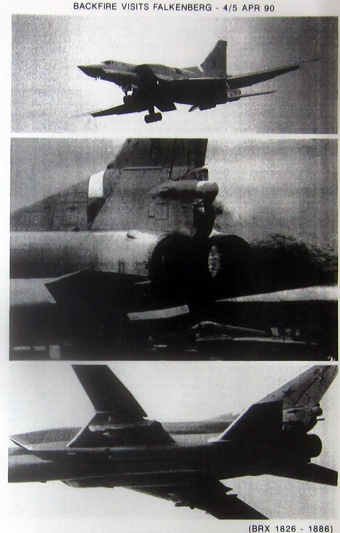 Huit Tu-22M3 se sont posé à Falkenberg le 3 avril 1990 et sont repartis un ou deux jours après. © BRIXMIS.
Huit Tu-22M3 se sont posé à Falkenberg le 3 avril 1990 et sont repartis un ou deux jours après. © BRIXMIS.
Eight Tu-22M3 landed at Falkenberg on April 3, 1990 and departed one or two days later. © BRIXMIS.
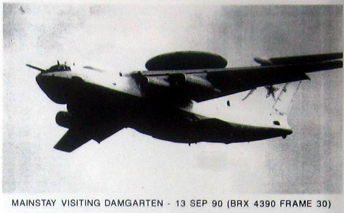 Un A-50 photographié à Damgarten le 13 septembre 1990. Les "Mainstay" ne se posaient pas nécessairement en RDA. © BRIXMIS.
Un A-50 photographié à Damgarten le 13 septembre 1990. Les "Mainstay" ne se posaient pas nécessairement en RDA. © BRIXMIS.
An A-50 photographed at Damgarten on September 13, 1990. The "Mainstay" did not necessarily land in the GDR. © BRIXMIS.
A large platform originally physically divided in slots to receive six Tu-16 was available at the south-east end of the main runway
(3500 x 80 meters - the longest runway in GDR), orientated east-west.
At the southern end of the second reserve runway (2500 x 60 m) orientated NNE / SSW, there were six additional parking zones specially designed to accommodate
as many Tu-16.
When it was built in the early fifties and during the following years (1952-56), Gross Dölln airbase was specially designed to accommodate heavy bombers on deployment
(4).
Deployments on various airfields of the 16th Air Army could involve sometimes up to a complete regiment, i.e. 20 to 30 aircraft. Thus, a bomber division
(around 60 to 80 Tu-16 and Tu-22M.) was dispersed around Berlin in May 1985 at Werneuchen, Brand and Gross Dölln airbases.
In addition to the bombers, Il'yushin-Beriev A-50 "Mainstay" AWACS aircraft also were observed occasionally in the GDR,
including at Damgarten and Lärz where an aircarft sometimes was stationed during joint aerial exercises with fighter aircraft. The A-50s were at the time on strength with the
67.OAE DRLO from Zoknyay (Siauliai) in Lithuania (where they replaced Tu-126 "Moss" AWACS from 1984 on); however they also joined the German skies from a detachement airfield at
Zhurzhevo (Smolensk) where the 339.VTAP with Il-76s was based.
| One summer in Poland... In late May or early June 1980, I was preparing for my Univerisity summer exams. On a nice and warm afternoon, I was sitting in my room with a law book in my hands. Suddenly I heard the sound of jet engines. In those times low-flying military jets were nothing unusual, even over the big cities, but I liked to see what was going on. I became more curious as the noise level slowly increased: it was much louder than just a lonely 'Fishbed' on afternoon patrol. I went on my balcony which is pointing eastwards. I saw plenty of people on the balconies of other flats, shouting and pointing to something over my home. Suddenly I saw a hard to believe sight: three silhouettes of Tu-16 'Badger' in perfect delta formation not much higher than about 1000 meters above my head. They were heading East, slow and majestic, with no fear. Soon after, another two appeared from behind. They were flying very close to each other, with all lights and warning strobes on and I could see a thin pipe joining both of them! "Air to air refuelling!!!" I shouted excited like a kid. Many neighbours knew that I am an aviation enthusiast, so they asked me "What is going on? Is this war?". No, I replied - just a group of Russian strategic bombers going home from exercises in East Germany. I told them to look at it as just a free air show and not to scare. Yes, I know that my home town of Torun is a bit north from the traditional 'Berlin - Moscow Autobahn', but what such a distance does mean for heavy bombers? Just a few minutes in the air! I could tell this story solemnly in a court, if anyone would like me to. Milosz Rusiecki. - The airfield and the country from which those Tu-16 took off remain uncertain - |
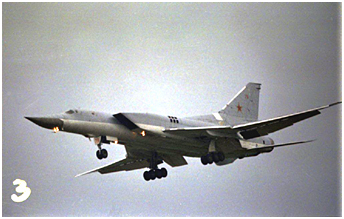 |
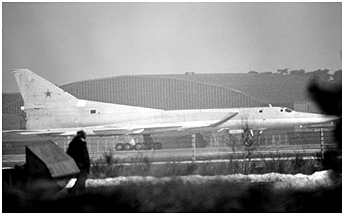 |
 | Air strike on Wittstock |  | Blinder over Berlin |
Known deployments (5)
> August 1960 : Tu-16 at Werneuchen
> June & August 1961 : Tu-16 at Werneuchen
> April 1963 : Tu-16 at Oranienburg
> August 1965 : two Tu-16 observed on take off at Grossenhain
> July 1969 : observation of several three-ship Tu-16 formations dropping aluminium chaffs in the Finow area.
27 Tu-16 in total took part to this action - aircraft based at Finow. The Tu-16 that dropped chaffs were clearly Tu-16 Yelka
> 6 July 1972 : bombardment of the Wittstock firing range at night by Tu-16 of the 132.TBAP coming directly from USSR
> August 1974 : Tu-16 of the Baltic Fleet (Bychov) at Werneuchen
> July 1975 : Tu-16 of the Baltic Fleet (Bychov) at Oranienburg
Tu-16 of the Baltic Fleet (Ostrov) at Werneuchen
> 1976 : Tu-16 of the Baltic Fleet at Oranienburg
> July 1978 : five Tu-16 of the Baltic Fleet seen at Werneuchen
> 1979 : annual deployment of Tu-16
> Mai 1980 : Tu-16 observed at Oranienburg (four Tu-16P 'Badger-J' and one Tu- 16 'Badger-A' identified)
> July 1983 : first deployment of Tu-22M2 "Backfire-B" outside the USSR at Gross Dölln
> June 1984 : landing of Tu-22K "Blinder-B" of the 121.GvTBAP at Gross Dölln and Falkenberg during Zapad 84 maneuvers
Tu-16 at Finow
> 1985 : deployment of a bomber division composed of Tu-16 and Tu-22M. at Werneuchen (June), Brand and Gross Dölln
> 1987 : Tu-22M3 "Backfire-C" at Falkenberg
> March & August 1988 : Tu-22M2 "Backfire-B" at Falkenberg
A-50 "Mainstay" at Falkenberg in March (seen orbiting above the Retzow and Wittstock firing ranges)
> April 1990 : last heavy bombers deployment in the GDR at Falkenberg (eight Tu-22M3)
notes
(1) During the 80's, the 46.VA controlled the following units :
- 199.GvODRAP : Tu-22R
- 290.ODRAP : Tu-22R
- 226.OAP REB : Tu-16P
- 13/15/22/326.TBAD : Tu-16/Tu-22/Tu-22M2
Read the page "Blinder over Berlin"
(2) NADGE network : NATO Air Defence Ground Environment
(3) Testimony of a radio-intercept operator based at Tegel.
(4) Three more airbases located in Warsaw Pact countries were also
adapted as advanced platforms for heavy bombers: Powidz in Poland, Mosnov
in Czechoslovakia and Mezökövesd-Klementina in Hungary
(from "Rote Plätze" par L.Freundt & S.Büttner - AeroLit).
(5) BRIXMIS - MMFL - USMLM - EES 32/351 - V.Kabanov - "Rote Plätze"
 |
Plan du site - Sitemap |  |

